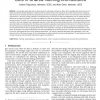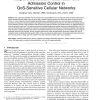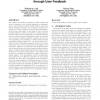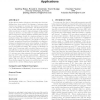663 search results - page 130 / 133 » On the Foundations of Expected Expected Utility |
BMCBI
2002
13 years 7 months ago
2002
Background: Expressed sequence tags (ESTs) are single pass reads from randomly selected cDNA clones. They provide a highly cost-effective method to access and identify expressed g...
TPDS
1998
13 years 7 months ago
1998
—Increasingly larger data sets are being stored in networked architectures. Many of the available data structures are not easily amenable to parallel realizations. Hashing scheme...
TPDS
2002
13 years 7 months ago
2002
How to keep the probability of hand-off drops within a prespecified limit is a very important Quality-of-Service (QoS) issue in cellular networks because mobile users should be abl...
CIKM
2010
Springer
13 years 6 months ago
2010
Springer
We consider the problem of learning to rank relevant and novel documents so as to directly maximize a performance metric called Expected Global Utility (EGU), which has several de...
ISCA
2010
IEEE
13 years 6 months ago
2010
IEEE
As the effective limits of frequency and instruction level parallelism have been reached, the strategy of microprocessor vendors has changed to increase the number of processing ...




